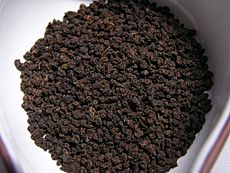Crush, tear, curl facts for kids
Cut, tear, curl (often called CTC) is a special way to make black tea. Instead of rolling tea leaves into long strips, this method uses machines with hundreds of sharp teeth. These machines crush, tear, and curl the tea leaves into tiny, hard pellets.
This process is different from the traditional "orthodox" way of making tea. Tea made with the CTC method is usually called CTC tea or mamri tea. It's very popular because it brews quickly and makes a strong, dark tea, which is great for tea bags.

History of CTC Tea
The very first CTC machine started working in 1930. It was used at the Amgoorie Tea Garden in Assam, a region in India. Sir William McKercher was in charge of setting it up.
Over the next 30 years, starting in the 1950s, the CTC method became very popular. It spread quickly, especially in India and Africa.
How CTC Tea is Made and Used
Today, most black teas are made using the CTC method or a similar process called rotorvane orthodox. Both methods create a finished tea that works really well for tea bags. This is because the small tea pellets quickly release their flavor and color, making a dark drink.
For many big tea companies, most of their tea (about 80% to 90%) is made into small, broken pieces perfect for tea bag blends. The rest are other types that are sold for less.
CTC teas are very popular in South Asia because they are:
- Easy to use
- Affordable
- Make a strong tea
- Have a general tea flavor
- Are only slightly bitter
In India, over 80% of the tea produced is CTC tea. It's also in high demand for export to places like the Commonwealth of Independent States (C.I.S.), the Middle East, the United Kingdom, and Ireland.
When CTC teas are brewed, especially using the Indian method (boiling), they usually turn a rich red-brown color.
Disadvantages of the CTC Method
One drawback of the CTC method is that it can make all black teas taste quite similar. When the tea leaves are crushed, torn, and turned into pellets, the process breaks down the tea cells. This can make the tea taste strong but lose some of its unique, subtle flavors.
Because dry CTC teas look and smell very much alike, it can be easy to mix more expensive CTC teas with cheaper ones. This makes it hard to tell the original quality of the tea leaves used in a blended tea. In contrast, whole or broken leaf teas look very different from each other, making it harder to mix them with cheaper varieties without being noticed.


